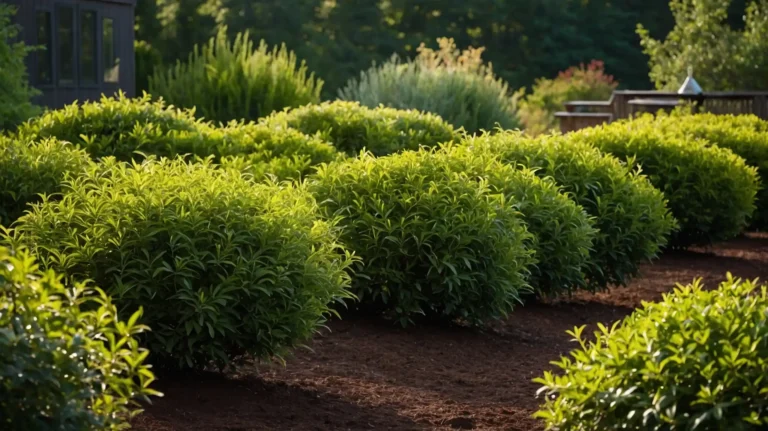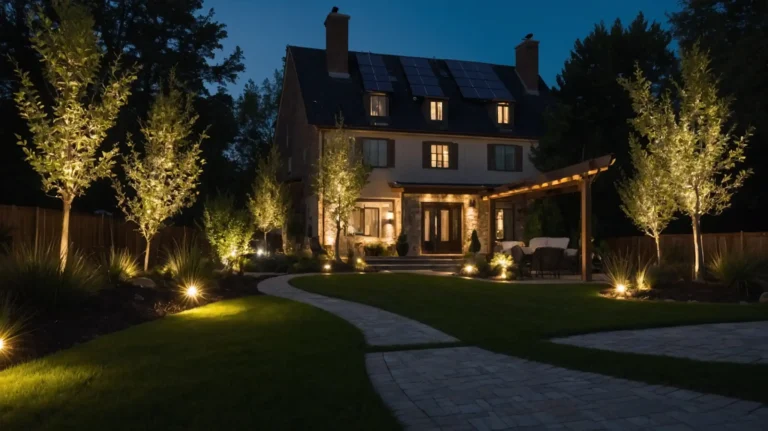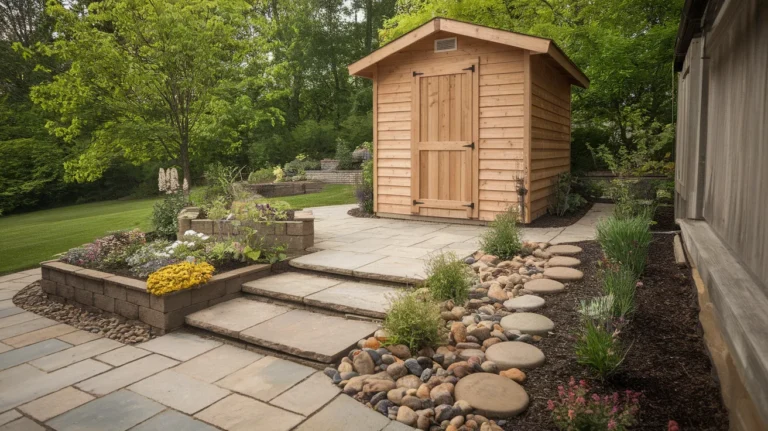27 Serene Spiritual Garden Ideas to Transform Your Outdoor Space into a Meditation Sanctuary
Creating a dedicated space for meditation in your garden can profoundly enhance your spiritual practice.
These sacred outdoor retreats provide a peaceful escape from daily stresses and reconnect you with nature’s healing rhythms.
The right spiritual garden combines elements that engage your senses while quieting your mind.
From simple additions to more elaborate designs, these spaces can be customized to reflect your personal spiritual path.
Whether you have a spacious backyard or a tiny balcony, these 27 spiritual garden ideas will help you design a meaningful outdoor sanctuary where you can meditate, reflect, and nurture your inner peace.
1: Stone Zen Garden
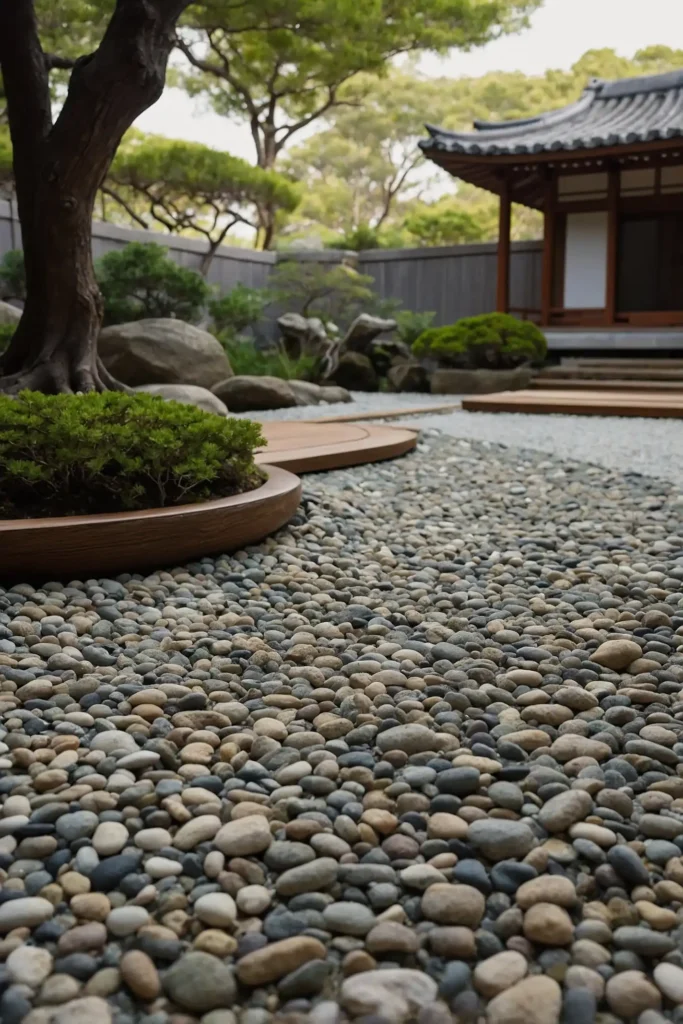
Create a minimalist meditation space using fine gravel or sand raked into wave patterns.
Add carefully positioned stones of varying sizes to represent islands or mountains rising from the sea.
This low-maintenance garden draws from Japanese traditions and provides a focal point for contemplative practice.
The act of raking becomes meditative in itself.
You can scale this concept to fit any space, from a tiny tabletop version to an expansive garden feature that you can walk through.
2: Buddha Statue Focal Point
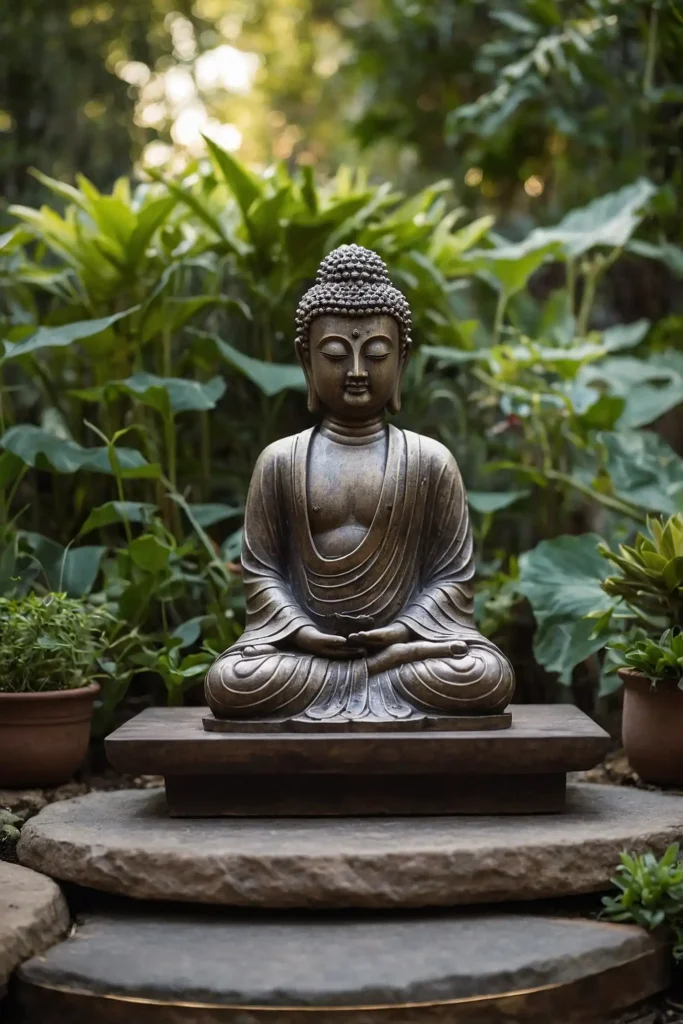
Position a serene Buddha statue as the centerpiece of your meditation garden.
Choose a size that feels proportionate to your space—from a small figure nestled among plants to a larger statement piece.
Place your statue on a stable platform slightly elevated from the surrounding area. This creates a natural focal point for your meditation practice.
Consider the direction your Buddha faces, as traditionally these statues face west or east. Surround it with simple, uncluttered plantings that won’t compete for attention.
3: Sacred Geometry Layout
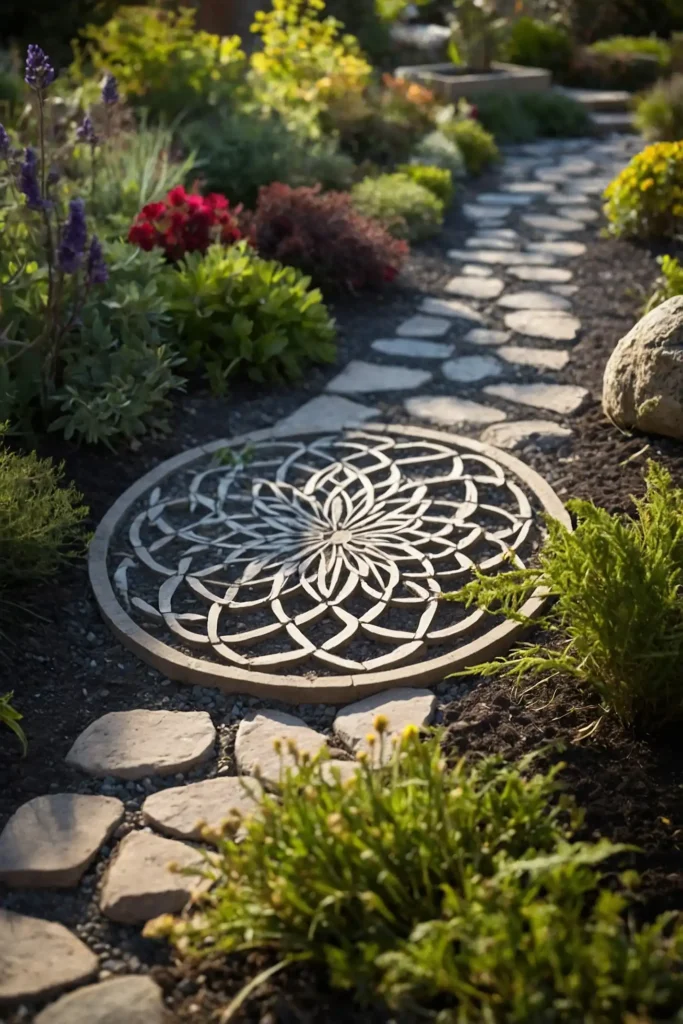
Design your garden paths or planting beds following sacred geometry patterns like the Flower of Life, Seed of Life, or simple mandalas.
These ancient patterns carry symbolic meaning across many spiritual traditions.
Create these patterns using stones, plants with contrasting colors, or defined pathways.
The geometric precision brings order and harmony to your garden space.
Walking these patterns becomes a moving meditation, allowing you to physically trace meaningful symbols with your body as you contemplate their significance.
4: Prayer Flag Garden Corner
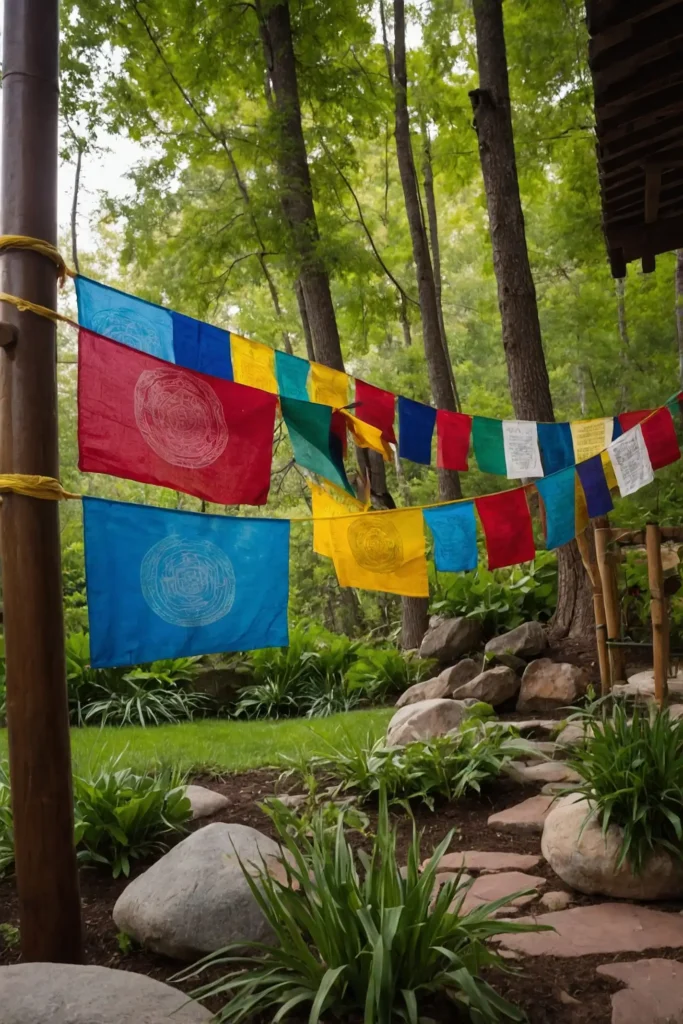
Hang colorful Tibetan prayer flags among trees or on dedicated posts to add movement, color, and intention to your spiritual garden.
According to tradition, the wind carries the prayers and mantras printed on these flags into the world.
Choose authentic flags with meaningful prayers or mantras that resonate with your practice.
The gentle fluttering creates both visual interest and a soothing soundscape.
Position them high enough to catch the breeze but still visible from your meditation seat.
Their fading over time symbolizes the impermanence central to many spiritual traditions.
5: Crystal Garden Integration
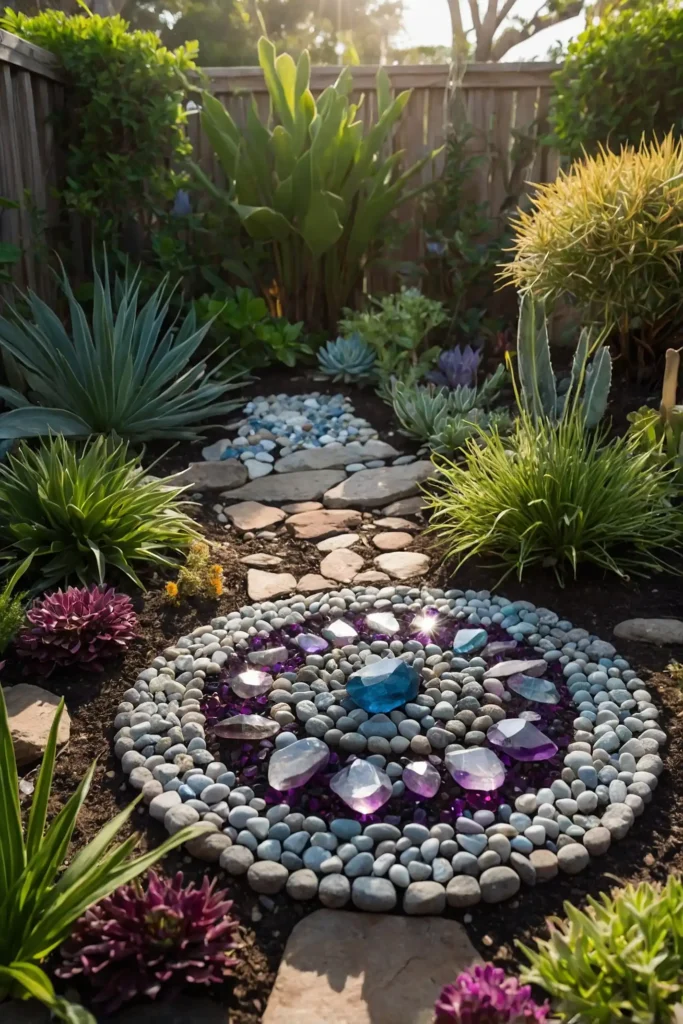
Incorporate crystals and gemstones into your garden design, selecting stones known for their grounding or spiritually enhancing properties.
Larger quartz points, amethyst clusters, or smooth river stones can become focal features.
Place crystals where sunlight will interact with them, creating prismatic light effects at certain times of day.
This adds magical, shifting elements to your meditation space.
Consider creating a crystal grid within your garden, positioning stones in meaningful patterns that support your meditation intentions and energy work.
6: Seven-Circuit Labyrinth

Build a classical seven-circuit labyrinth using stones, low hedges, or ground cover plants with contrasting colors.
Unlike mazes designed to confuse, labyrinths offer a single path to the center and back.
Scale your labyrinth to fit your available space—even a small one can be effective if designed thoughtfully.
The journey to the center represents your spiritual path.
Walking this ancient pattern quiets the analytical mind as you surrender to the journey. The center typically contains a special element like a statue, crystal, or small altar.
7: Meditation Sound Garden

Create a garden area that engages your sense of hearing with elements that produce gentle, meditative sounds.
Wind chimes tuned to specific healing frequencies add both melody and movement.
Include a small water feature with the gentle sound of trickling water. Position wind-catching plants like ornamental grasses or bamboo that create natural rustling sounds.
These acoustic elements mask urban noise pollution and create a soothing soundscape that helps quiet the mind during meditation sessions.
8: Spiritual Pathway
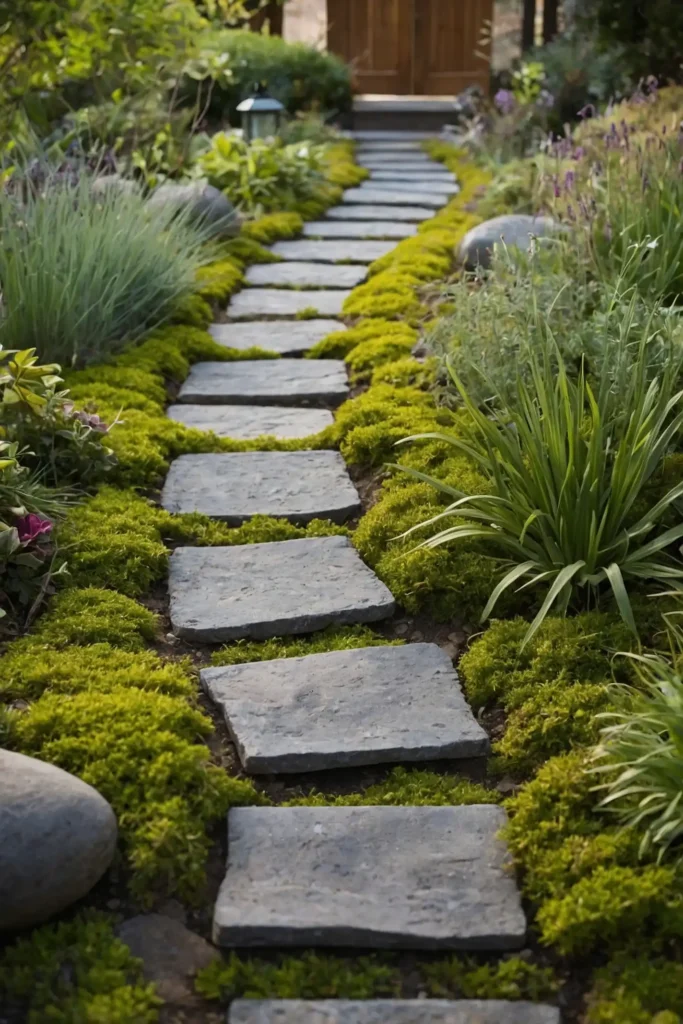
Design a winding path through your garden using materials that feel good underfoot—smooth stones, fine gravel, or soft moss.
This path symbolizes your spiritual journey.
Create stopping points along the way with small benches or meaningful objects that invite contemplation.
The journey becomes as important as the destination.
Consider adding threshold elements like torii gates or moon gates to mark transitions between different garden spaces, symbolizing passage between ordinary and sacred realms.
9: Four Elements Garden
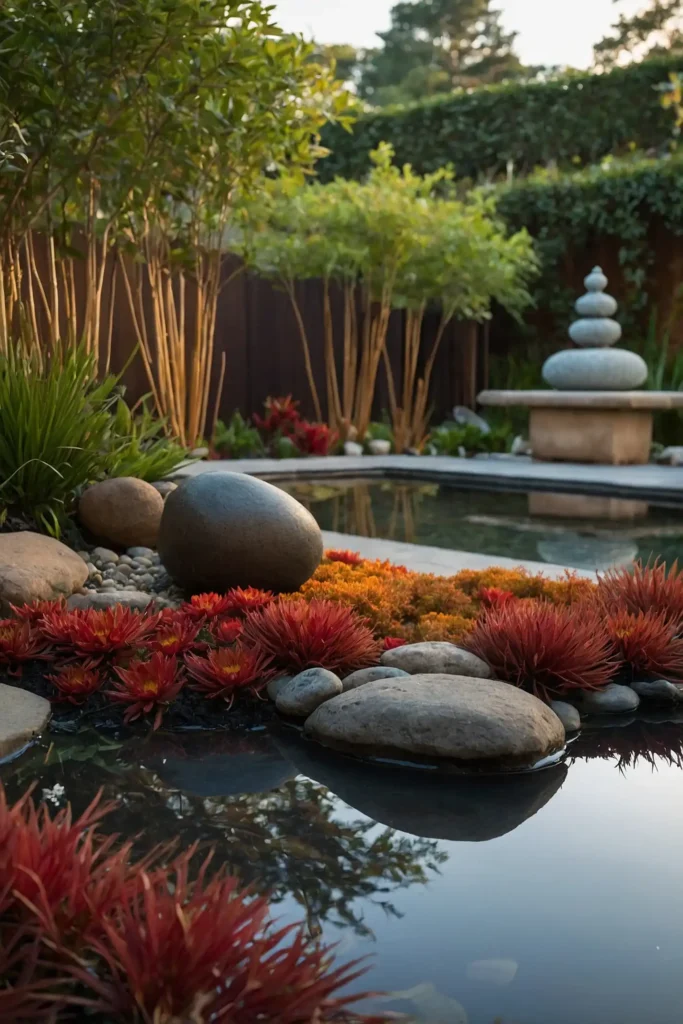
Design garden sections representing earth, air, fire, and water—the four elements central to many spiritual traditions.
This creates balance and harmony while acknowledging nature’s fundamental forces.
Represent earth with stones and grounding plants, air with space and movement, fire with candles or red/orange flowers, and water with a small fountain or reflecting pool.
Position these elements in relation to the cardinal directions for additional symbolic meaning.
Your meditation practice can focus on different elements depending on your needs.
10: Moon Garden for Evening Meditation
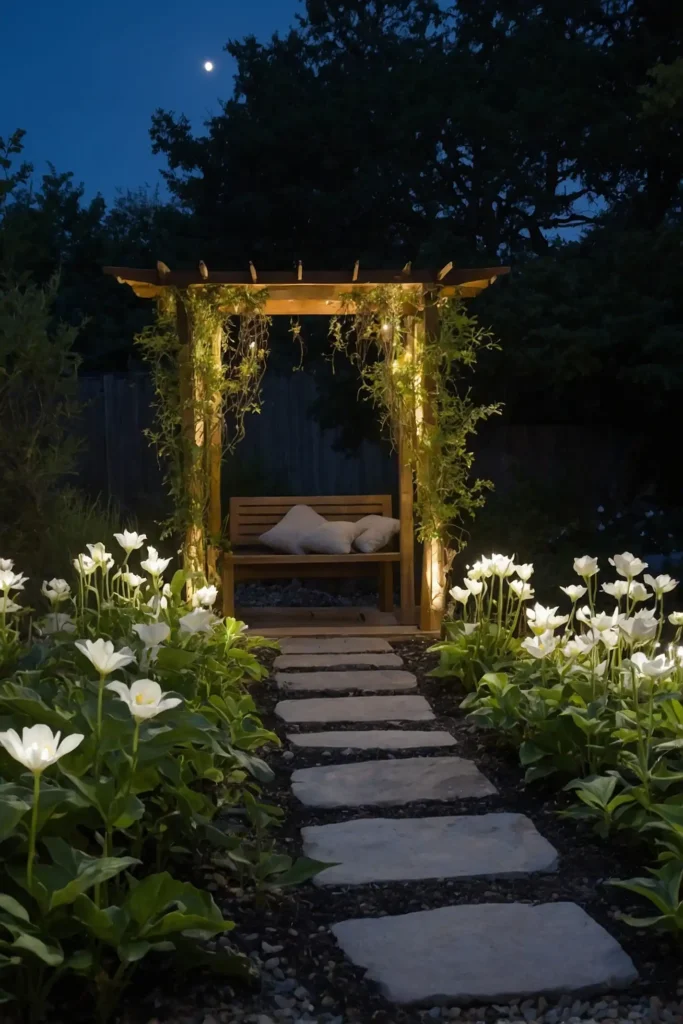
Plant white and silver-leaved plants that reflect moonlight, creating a luminous garden space for evening meditation practices.
These gardens glow during full moons and encourage night-time spiritual connection.
Include night-blooming flowers like evening primrose or moonflower that release sweet fragrance after sunset.
Their unfurling becomes a meditation timer marking the transition to evening.
Add solar-powered or low-voltage lighting with a bluish tint to enhance the moonlit quality when natural moonlight isn’t available.
11: Prayer or Mala Bead Path
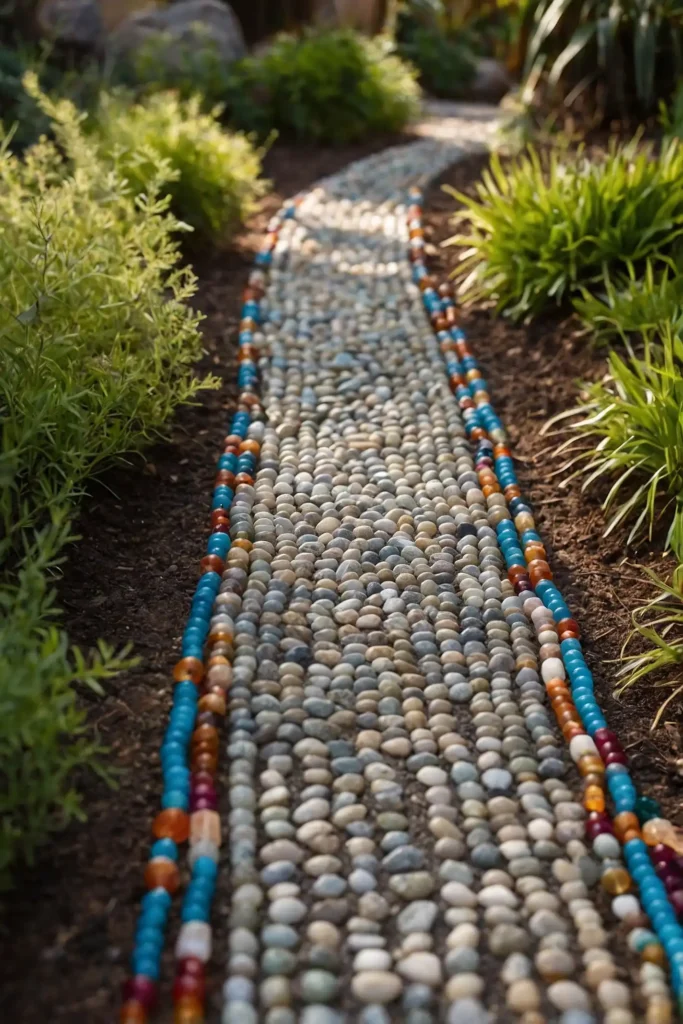
Create a pathway using large, smooth stones painted or arranged to resemble oversized prayer beads or mala beads.
This becomes both a visual element and a walking meditation tool.
Design your path with 108 stones to match traditional mala bead counts, or choose another number significant to your spiritual tradition.
Each stone represents one prayer or mantra repetition.
Walking this path allows you to physically move from bead to bead, combining movement with meditation while engaging with an ancient spiritual counting system.
12: Goddess Garden
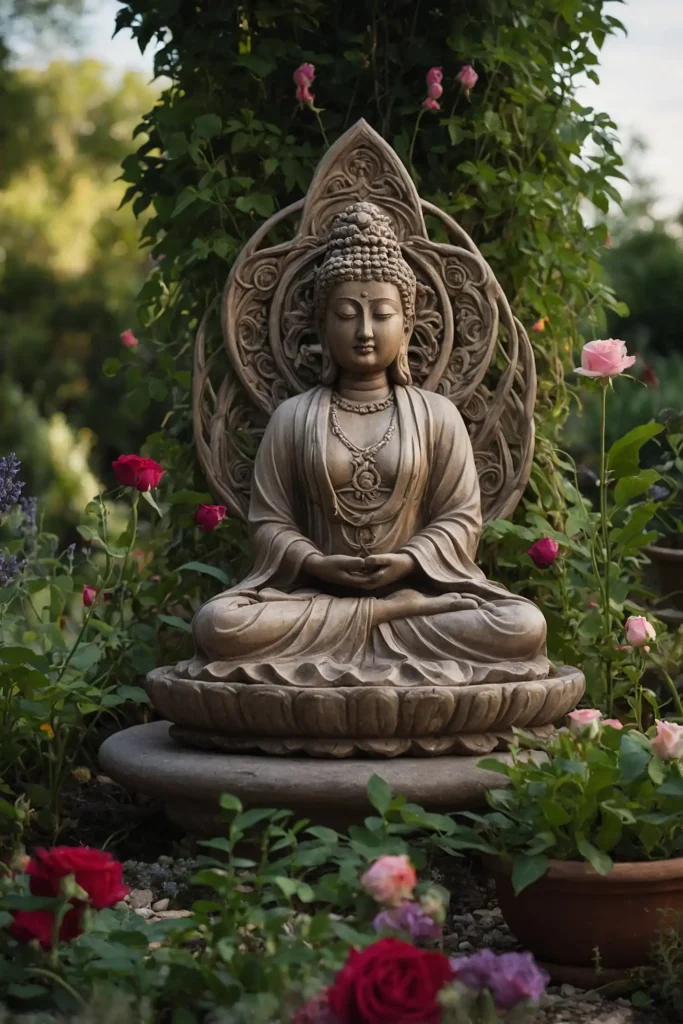
Dedicate your spiritual garden to feminine divine energy with a central statue representing a goddess from your preferred tradition—whether Quan Yin, Gaia, Diana, or another feminine archetype.
Surround your goddess figure with plants traditionally associated with feminine energy, such as roses, lavender, or moonwort.
The space becomes a tribute to nurturing, intuitive qualities.
Add a small altar where you can leave offerings or set intentions related to the goddess energy you’re working with in your spiritual practice.
13: Medicinal Herb Spiral

Construct a spiral-shaped raised bed filled with medicinal and spiritual herbs used across various traditions.
The spiral design maximizes growing space while creating different microclimates.
Plant traditional spiritual herbs like lavender, sage, rosemary, and mugwort, arranging them according to their water and sun needs.
The act of tending these plants becomes part of your practice.
The spiral shape reflects patterns found throughout nature and creates a mandala-like feature that serves both practical and meditative purposes.
14: Singing Bowl Water Feature
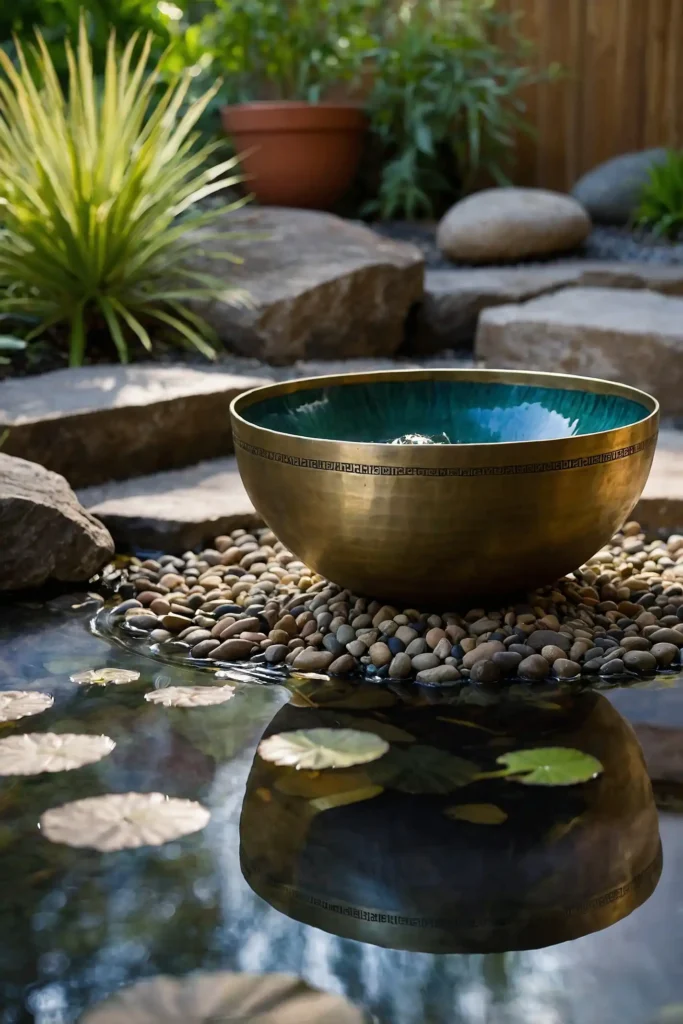
Commission or create a water feature inspired by Tibetan singing bowls.
Water flowing into or over a metal bowl creates both visual interest and meditative sounds.
Position your water feature where you can easily see and hear it during meditation sessions.
The continuous flow reminds you of impermanence and life’s constant movement.
Some designs allow you to occasionally use the empty bowl as an actual singing bowl, adding versatility to your meditation space.
15: Sunrise/Sunset Meditation Platform
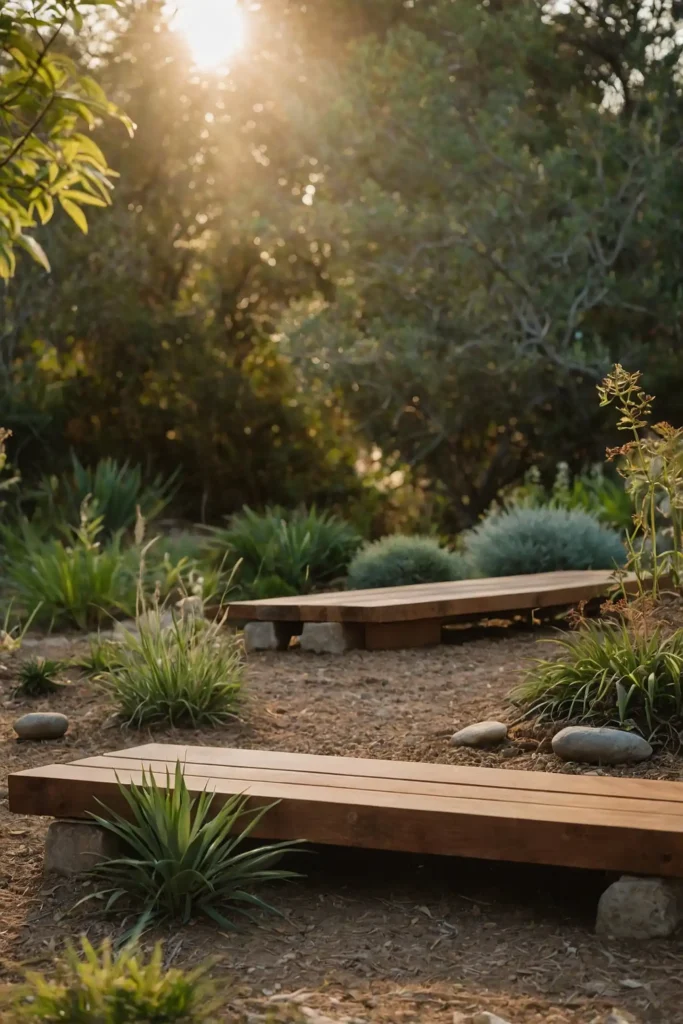
Build a dedicated platform or seating area oriented to capture either sunrise or sunset views, depending on your preferred meditation time.
This alignment connects your practice to cosmic rhythms.
Position your platform with clear sightlines to the horizon if possible.
Simple benches facing east or west create a practical meditation spot aligned with solar cycles.
This intentional alignment helps you develop consistency in your practice by connecting it to the reliable daily movement of the sun.
16: Tree of Life Centerpiece
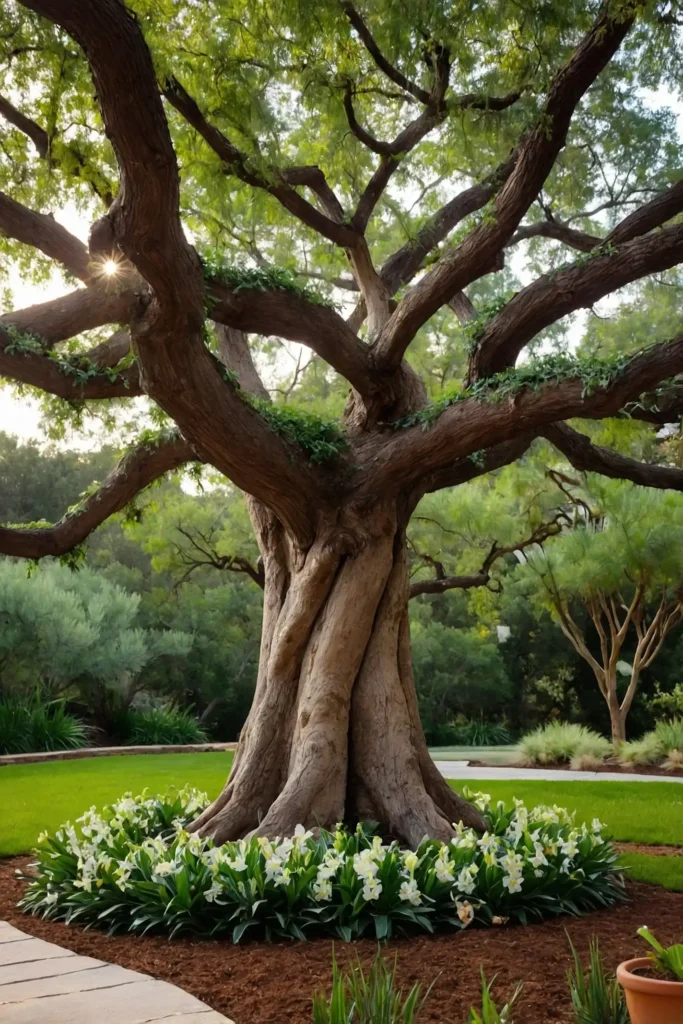
Plant a significant tree as your garden’s centerpiece, symbolizing the Tree of Life concept found in numerous spiritual traditions.
Choose a species with meaning to you or significance in your spiritual path.
Create a seating area beneath or around this tree where you can meditate in its protective presence.
The tree becomes a living altar and grows along with your spiritual practice.
Consider species like oak for strength, willow for flexibility, or bodhi for enlightenment, depending on the qualities you wish to cultivate in your practice.
17: Chakra Garden Beds

Design seven garden beds representing the seven chakras, using plants whose colors correspond to each energy center—red for root, orange for sacral, yellow for solar plexus, and so on.
Arrange these beds in a vertical line or spiral formation moving from ground level upward.
This physical representation of your body’s energy centers creates a powerful meditation tool.
Walking from one bed to the next becomes a chakra balancing practice, helping you bring awareness to each energy center through color, plant energy, and intention.
18: Mindful Rain Collection
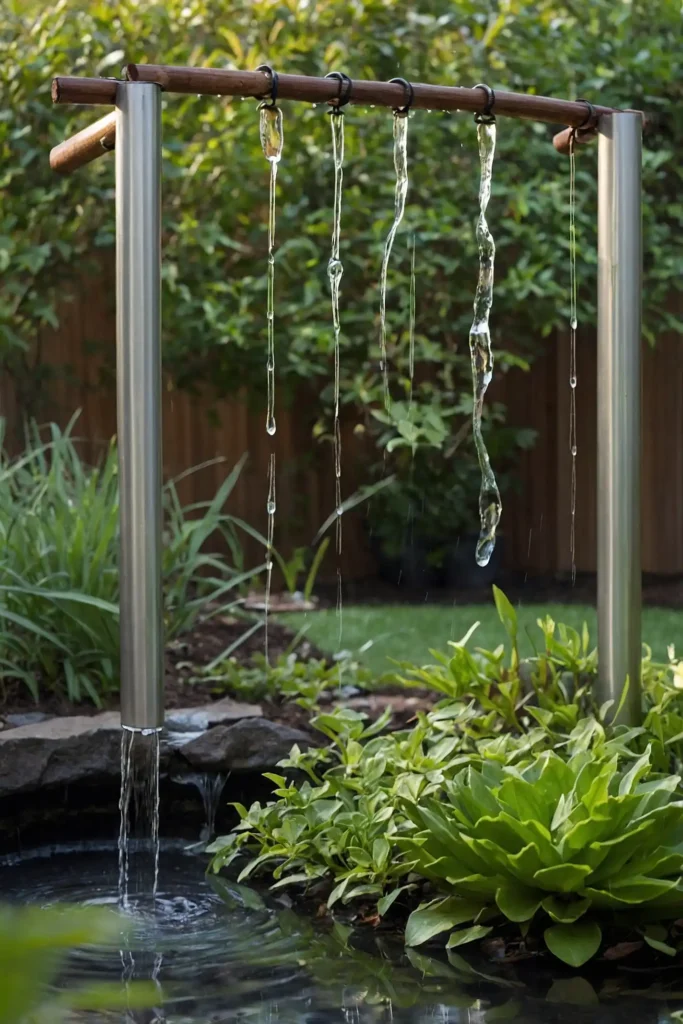
Install beautiful rain chains, decorative barrels, or a small reflecting pool to collect rainwater for your garden.
This practical element carries spiritual significance related to purification and the water cycle.
Position these elements where you can observe and appreciate rain as it falls.
The sound of water during rainstorms adds another sensory dimension to your garden.
This feature connects your garden to natural cycles and heavenly waters, concepts important in many spiritual traditions.
19: Stone Cairn Meditation Stations
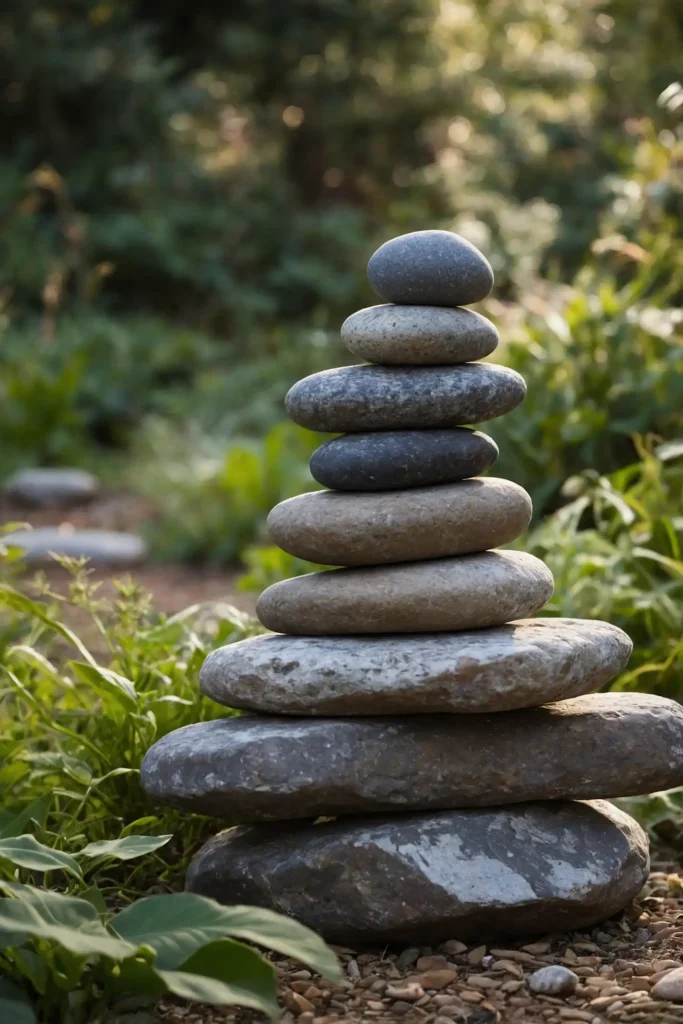
Create balanced stone cairns (stacked stones) at key points throughout your garden.
These serve as reminders to pause, breathe, and return to mindfulness as you move through the space.
Build cairns with stones that feel good in your hands and stack well. The practice of carefully balancing these stones becomes a meditation in itself.
Their impermanence—occasionally falling and needing to be rebuilt—teaches valuable spiritual lessons about letting go and beginning again.
20: Botanical Mandala Garden
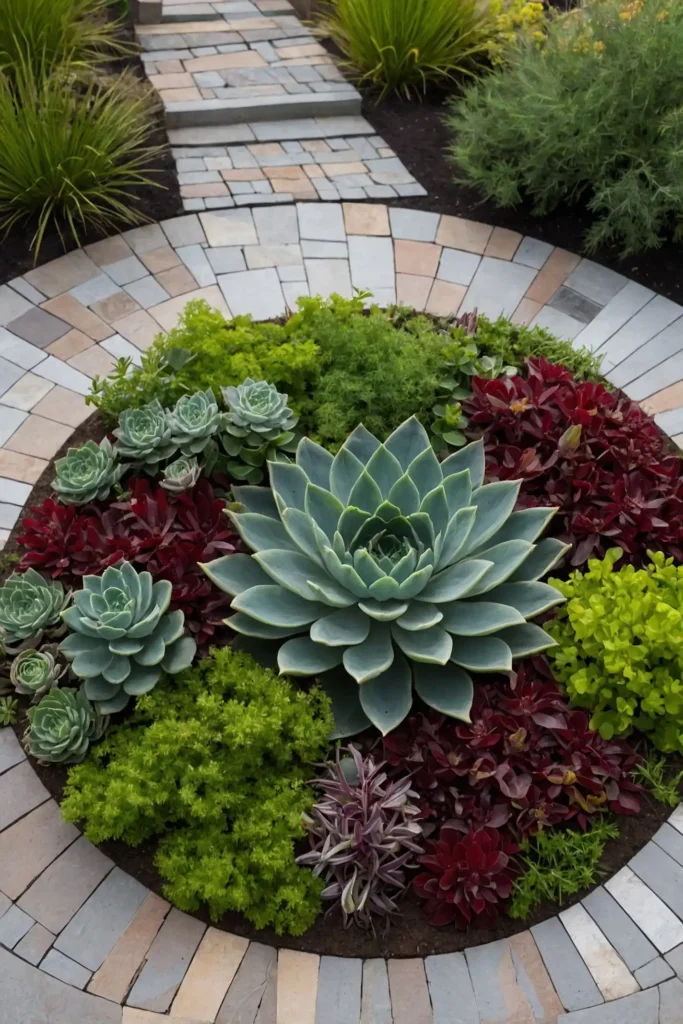
Design a circular garden bed divided into segments like a mandala, using plants with different colors, textures, and heights.
This living mandala serves as both a meditation focus and a beautiful garden feature.
Choose plants that create clear color blocks and defined edges for the most striking visual impact.
Aromatic herbs add another sensory dimension to your mandala experience.
The circular form represents wholeness and completion, while the symmetrical design helps focus and quiet the mind during contemplative practice.
21: Bell or Gong Station
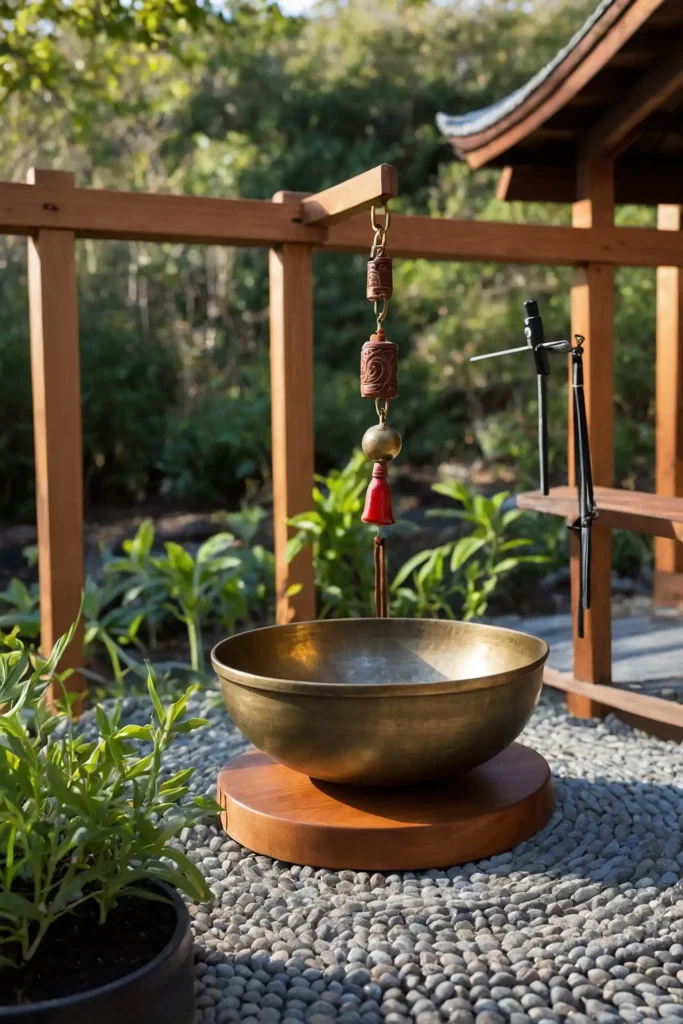
Install a garden bell, gong, or singing bowl on a weather-resistant stand.
This allows you to mark the beginning and end of your meditation sessions with sound.
Position your sound instrument near your primary meditation seat for easy access.
The reverberating tones create an immediate shift in awareness.
These traditional meditation tools help define your practice time and create a sonic boundary between everyday consciousness and meditative states.
22: Meditation Stepping Stones

Create a series of round stepping stones with words, symbols, or mantras embedded or painted on their surfaces.
Each stone presents a contemplation focus for slow, mindful walking meditation.
Space these stones at a distance that requires conscious attention to move from one to the next.
The words or symbols should progress through a meaningful sequence.
This walking practice combines physical movement with mental focus, making it excellent for those who struggle with seated meditation.
23: Ancestral Corner

Dedicate a secluded corner of your garden to honoring ancestors and loved ones who have passed.
This creates space for connection and remembrance within your spiritual practice.
Include a small shelf or altar for photographs or mementos, protected from the elements.
Add plants with personal significance or traditional remembrance flowers.
This sacred space acknowledges the continuity between past and present, allowing you to incorporate gratitude for those who came before into your spiritual practice.
24: Butterfly and Pollinator Sanctuary

Dedicate part of your meditation garden to plants that attract butterflies, bees, and hummingbirds.
These creatures bring movement, sound, and life while symbolizing transformation and divine messengers.
Choose native flowering plants that provide food sources throughout the growing season.
Position them where you can observe these visitors during meditation sessions.
The presence of these small creatures adds unpredictable moments of delight and connection to your meditation practice, reinforcing the interconnectedness of all beings.
25: Garden Oracle Station
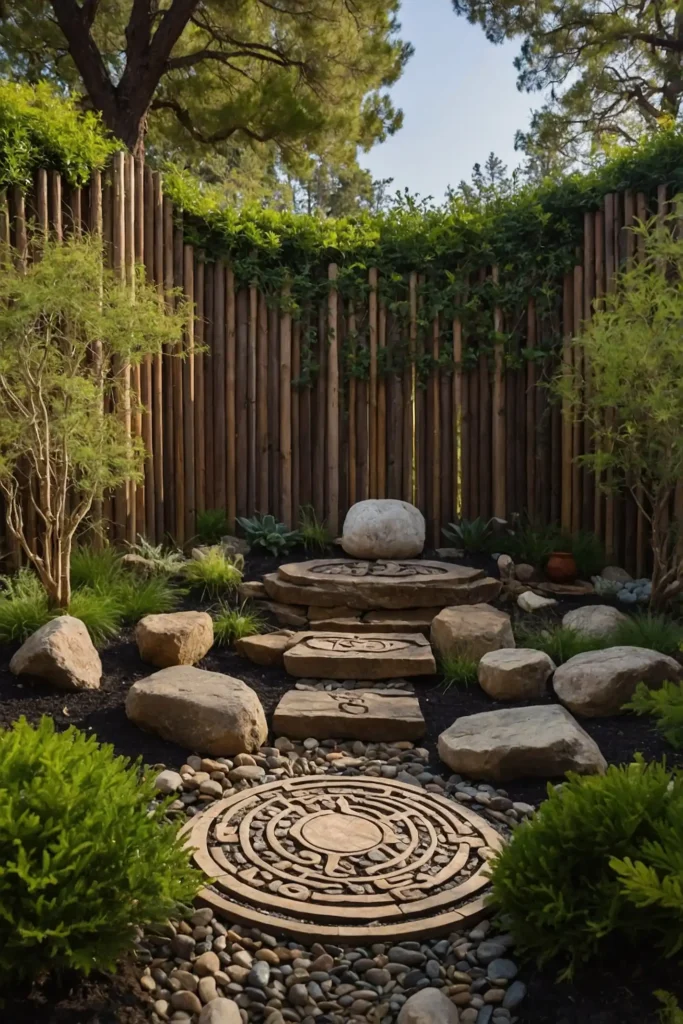
Create a special area with divination tools suited for outdoor use, such as weather-resistant rune stones, a labyrinth finger tracer, or a meditation coin flip station for answering yes/no questions.
Design simple storage solutions that protect these tools while keeping them readily accessible.
Your meditation can include consulting these wisdom tools when seeking guidance.
This dedicated space encourages you to develop intuition and connect with deeper wisdom as part of your regular spiritual practice.
26: Barefoot Sensory Path

Design a short garden path with sections of different textures meant to be walked barefoot—smooth stones, fine sand, soft moss, rounded pebbles, and cool grass create contrasting sensations.
Make each section about two feet long to allow enough steps to fully experience the texture.
This path becomes an exercise in mindfulness through physical sensation.
Walking this path barefoot grounds your energy and brings attention fully into the body, creating an immediate shift into present-moment awareness.
27: Personal Spiritual Symbol

Incorporate a large-scale representation of a spiritual symbol that holds deep personal meaning—whether a cross, om symbol, star of David, crescent moon, or pentacle.
Create this symbol using plants, stones, or as a sculptural element that serves as the organizing principle for your garden design.
Its presence continuously reconnects you to your spiritual foundations.
Position this symbol where it can be seen from your main meditation seat, serving as a focal point that immediately centers your attention when you begin your practice.
Conclusion
Your spiritual garden becomes more meaningful with each meditation session you practice there.
Start with one or two elements that resonate most deeply with you, then gradually expand your sacred outdoor space as your spiritual practice deepens and evolves.




